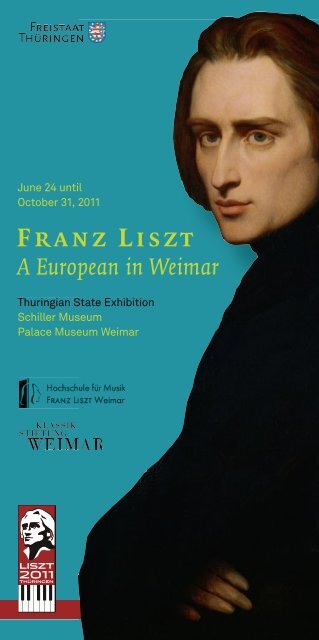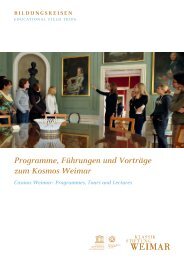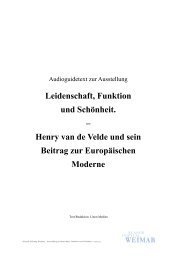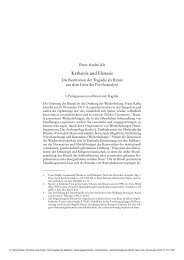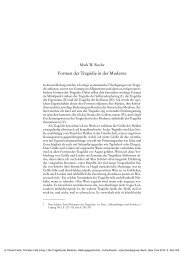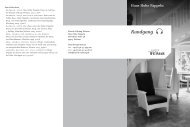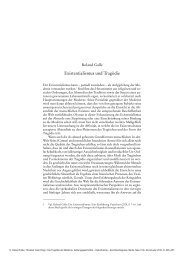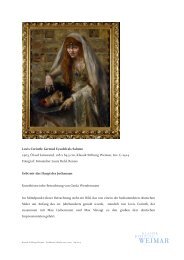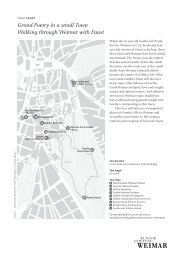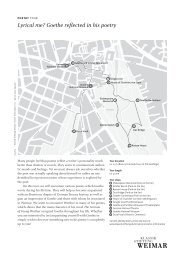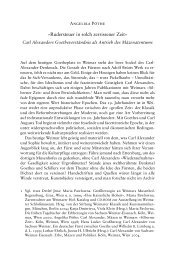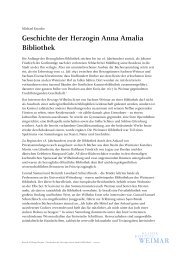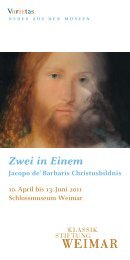FRANZ LISZT · EIN EUROPÃER IN WEIMAR - Klassik Stiftung Weimar
FRANZ LISZT · EIN EUROPÃER IN WEIMAR - Klassik Stiftung Weimar
FRANZ LISZT · EIN EUROPÃER IN WEIMAR - Klassik Stiftung Weimar
You also want an ePaper? Increase the reach of your titles
YUMPU automatically turns print PDFs into web optimized ePapers that Google loves.
June 24 until<br />
October 31, 2011<br />
Franz Liszt<br />
A European in <strong>Weimar</strong><br />
Thuringian State Exhibition<br />
Thuringian State Exhibition<br />
Schiller Museum<br />
Palace Museum <strong>Weimar</strong>
Now I like to think first of <strong>Weimar</strong>, my lodestar,<br />
whose benevolent rays shed light on my winding<br />
road, […] of <strong>Weimar</strong>, the Fatherland of the ideal.<br />
Liszt to Arch Grand Duke Carl Alexander, 1846<br />
On the occasion of the composer’s 200th birthday,<br />
<strong>Weimar</strong> invites you to visit the 2011 state exhibition:<br />
Franz Liszt<br />
A European in <strong>Weimar</strong><br />
The exhibition focuses on the European dimensions<br />
of the personality, the composer and the interpreter<br />
as well as the artistic projects realised in <strong>Weimar</strong>.<br />
Liszt’s right hand, replica by unknown artist, probably around 1840
Liszt’s Hungarian passport, 1874<br />
Franz Liszt, statuette by Károly Dosnyay, 1840<br />
And because I showed myself as I was: an enthusiastic<br />
child, a firm believer, in a word everything one<br />
is when one is 18 […], because I did not know how<br />
to play comedy, I gained the reputation – of being<br />
an actor.<br />
Liszt, Reisebriefe eines Baccalaureus der Tonkunst<br />
(Travelogues by a Baccalaureate of Musical Art), 1837<br />
The first part of the exhibition in the Schiller Museum follows<br />
the stages of Liszt’s life from the multicultural climate of the<br />
Habsburg monarchy via Paris, Switzerland, Italy and the virtuoso<br />
tours to <strong>Weimar</strong>, where most of his major compositions were<br />
written over a period of little more than ten years. These stages are<br />
presented in the form of a pilgrimage with <strong>Weimar</strong> as the destination<br />
and climax. The exhibition documents not only Liszt’s work<br />
and compositions, but also his significance in Europe’s history of<br />
music and thought.<br />
As a pianist, Liszt’s concert tours in the late 1830s and early<br />
1840s took him all over Europe – from Paris to Constantinople,<br />
from Milan to St. Petersburg. He came to <strong>Weimar</strong> quite early, where<br />
he was appointed the court’s music director extraor dinaire in 1842.<br />
In Berlin, Liszt triggered an unparalleled “Lisztomania”, the effects
City Palace, Ballroom, about 1830<br />
Liszt knows no rules, no form, no regulations,<br />
he makes them all himself! The bizarre becomes<br />
brilliant, the alienatory a condition for living.<br />
M. G. Saphir about Liszt, 1838<br />
of which inspired Ken Russell to make his film of that name. Half<br />
Europe lay at Liszt’s feet. He was the idol of an entire generation.<br />
The public engaged in a lively trade in devotional objects ranging<br />
from medals to alabaster busts, from Liszt portraits to album leaves.<br />
The exhibition displays precious autographs from the world’s<br />
largest Liszt collection held by the Goethe and Schiller Archive<br />
alongside Lisztiana from the collections in the Duchess Anna Amalia<br />
Library and the museums of the <strong>Klassik</strong> <strong>Stiftung</strong> <strong>Weimar</strong>. The<br />
range of exhibits, supplemented by items borrowed from Germany<br />
and abroad, covers items personally used by Liszt, contemporary<br />
paintings and drawings, artworks, concert programmes and first<br />
editions of his works.
Liszt in the concert hall, after a drawing by Theodor Hosemann, 1842<br />
Liszt’s grand piano from the company “Boisselot & fils”, Marseille 1846<br />
We had never heard anything like it in our lives,<br />
never such a passionate, brilliant and demonic<br />
temperament, one minute lashing like a whirlwind,<br />
the next flowing in cascades of beauty and grace.<br />
Liszt’s playing was absolutely overwhelming […]<br />
W. Stasov, about a concert in St. Petersburg, 1842<br />
The second part of the exhibition in the Palace Museum is titled<br />
Piano Cosmos and traces the technical development, tonal aesthe tics<br />
and cultural history of the piano in Liszt’s era. It deals with the role<br />
of piano music in 19th century salons and concert halls, the interdependence<br />
of piano making and compositional techniques, and<br />
the instrument’s significance for the educational ideals of that time.<br />
The <strong>Weimar</strong> instruments restored with the support of the Federal<br />
Cultural Foundation will be seen and heard for the first time in this<br />
context.<br />
The exhibition focuses on the models by piano makers Graf<br />
(Vienna), Streicher<br />
(Vienna) and Erard (Paris/London), all played<br />
by the composer himself. One key feature is the especially reconstructed<br />
grand piano by the Marseille piano makers Boisselot & fils;<br />
Liszt used it not only for composing but also as a travelling piano.
Letter of honorary citizenship of the royal city of <strong>Weimar</strong> awarded to Franz Liszt, 1860<br />
Believe me that I am not chasing after orders,<br />
or praise, or awards, or newspaper articles […]<br />
My sole ambition as a musician was and always<br />
will be to cast a spear into the infinite space of<br />
the future.<br />
Liszt to Carolyne von Sayn-Wittgenstein, 1874<br />
Another highlight is the overzized walk-through grand piano in the<br />
palace courtyard. Inside the grand piano, visitors can hear and feel<br />
the vibrations produced when various strings are struck from the<br />
outside. This direct physical and tonal experience will open up the<br />
topic of the exhibition to children in particular.<br />
We also recommend a visit to Altenburg, Liszt’s home in <strong>Weimar</strong><br />
from 1849 to 1861, and to Liszt’s Home, used by Liszt as a summer<br />
residence between 1869 and 1886.<br />
Liszt at the piano,<br />
caricatures by János Jankó, 1873
Piano Cosmos<br />
The world of sound created by the piano in the 19th century is incredibly<br />
varied. Every piano maker has his own idea of the perfect tone. And the<br />
views of the great composers and interpreters on the sound of the piano<br />
differ greatly.<br />
The instruments belonging to the <strong>Klassik</strong> <strong>Stiftung</strong> <strong>Weimar</strong>, the<br />
Beetz collection and the Greifenberger Institute are displayed<br />
in the Palace Museum and invite visitors to make a unique tour<br />
of discovery: The Piano Cosmos becomes a living organism.<br />
Selected instruments are presented and played with reference to<br />
the piano maker’s craft of that time. Along with regular presentations<br />
by students of The Liszt School of Music <strong>Weimar</strong>, Liszt’s<br />
anniversary year 2011 will be marked by many other concerts:<br />
www.liszt-2011.de<br />
Erard grand piano, Paris 1811
Pla<br />
De<br />
Goetheplatz<br />
Herderplatz<br />
Schiller Museum<br />
Market<br />
Schillerstraße 12<br />
Schiller’s Home<br />
Frauenplan<br />
Goethe’s Home<br />
Liszt’s Home<br />
Park<br />
Cave<br />
Marienstraße 17<br />
Historical Cemetery
Jenaer Straße 3<br />
Altenburg<br />
Palace Museum<br />
Burgplatz 4<br />
City Palace<br />
Duchess<br />
Anna Amalia<br />
Library<br />
tz der<br />
mokratie<br />
Park on the Ilm river<br />
Liszt Monument<br />
100 m
Franz Liszt · A European in <strong>Weimar</strong><br />
June 24 until October 31, 2011<br />
Schiller Museum & Palace Museum <strong>Weimar</strong><br />
Tues–Sun 10 am–6 pm adults 8 € / reduced 6 € / pupils 3 €<br />
Free entrance for children and young people under 16 years of age<br />
and holders of the ThüringenCard<br />
Cultural Programme<br />
Fri & Sat 3 pm, Sun 1 pm | Tour of Palace Museum with music (German)<br />
On request | Guided Tours in English through Schiller-Museum,<br />
Palace Museum <strong>Weimar</strong> and Liszt’s Home<br />
Fri 2–6 pm, Sat 10 am – 6 pm, Sun 10 am–2 pm | Events for children and<br />
families in the palace courtyard<br />
Individual | Tours with audio guide in English and German<br />
Kultur-Ticket-Spezial (culture ticket special)<br />
Travel with the Deutsche Bahn “Kultur-Ticket-Spezial” (culture ticket<br />
special) for only 39€ (2nd class) and 59 € (1st class) per person to the<br />
exhibition and back in one day. Information at www.bahn.de/kultur<br />
Combi ticket for State Exhibition & Liszt’s Home<br />
adults 10 € / reduced 7 € / pupils 3,50 €<br />
Holders of the Liszt combi ticket can pay one visit each to the<br />
exhibitions in the Schiller and Palace Museum and to Liszt’s Home.<br />
Liszt’s Home with permanent exhibition and living areas<br />
Tues–Sun 10 am–6 pm (single or combi ticket)<br />
Altenburg with exhibition about the Allgemeine Deutsche Musikverein *<br />
Tues–Sun 1–3 pm (admission free) *General German Music Society<br />
Visitor Information<br />
Tel +49 (0) 36 43 | 545-400 · Fax +49 (0) 36 43 | 41 98 16<br />
info@klassik-stiftung.de · www.klassik-stiftung.de/liszt<br />
Mobility Partner<br />
Project Partners<br />
Media Partners<br />
Stadtwerke <strong>Weimar</strong><br />
Stadtversorgungs-GmbH<br />
Möbelspedition<br />
Staupendahl <strong>Weimar</strong><br />
Cover picture: Portrait of Franz Liszt | Ary Scheffer, 1837–39<br />
www.klassik-stiftung.de/liszt


